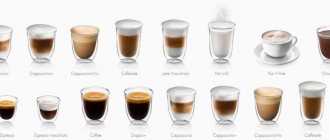How they are prepared
One of the key differences between these three caffeinated drinks is how they are prepared.
Cappuccino
Cappuccino is a popular coffee drink made from espresso with the addition of heated and frothed milk.
Typically it contains equal parts of each and consists of about 1/3 espresso, 1/3 warmed milk and 1/3 steamed milk.
This gives the final product a creamy, rich flavor and consistency.
Latte
The term "café latte" literally translates to "coffee with milk".
While there is no standard recipe for making a latte, it usually involves adding warmed milk to one shot of espresso.
In some cases, it is also covered with a light layer of foam, and sugar or sweeteners may also be added.
Compared to other drinks, latte has a milder, slightly sweet taste, as it contains a higher proportion of heated milk.
Macchiato
Traditionally, a macchiato is made by combining espresso with a small amount of milk.
However, many other variations are available, including latte macchiato, which is made by adding espresso to a glass of hot milk.
Because macchiato is usually made with a small amount of milk, it has a much stronger flavor than other coffee drinks.
Plus, one serving of macchiato is also much smaller than servings of other drinks - a standard serving is only 37 ml.
Summary:
A cappuccino is made using equal parts of espresso, heated milk and steamed milk, while a latte involves adding heated milk to the espresso. Meanwhile, a macchiato is prepared by adding a small amount of milk to a shot of espresso.
Coconut Milk Drink Recipes
The taste of your favorite coffee and the background of coconut milk are a great combination. But people losing weight, who prefer diets to enjoying “goodies,” see harm in a wonderful cocktail. The fat and calorie content of saturated coconut milk is indeed high, but with moderate consumption it still provides more benefits. The safe dose for waist size is 100 ml of the product 2 times a week.
Let's remember this recommendation and prepare coffee with coconut milk in several versions.
Classic recipe
Required:
- natural ground coffee – 1 heaped teaspoon;
- coconut milk – 50 ml;
- pure filtered water – 100 ml;
- sugar - optional and to your taste.
We brew coffee in a Turk in the usual way, leave for 2-3 minutes. Pour into a large ceramic cup with thick walls. Beat the cooled coconut milk in a French press and heat for 1 minute in the microwave. You can first heat the milk and then beat it with a microcappuccino maker (milk frother). Add sugar to the coffee, if required, and whipped coconut product. Mix everything thoroughly and serve hot.
Coconut cappuccino
Coconut milk is often called “Asian cream” for its ability to whip well and quickly into a dense foam. Why not take advantage of this advantage to make your favorite cappuccino?
What you will need:
- 50 ml espresso;
- 50 ml coconut milk.
We prepare espresso in a convenient way: in a coffee machine, coffee maker, or French press. You can also cook it in a Turk, but then strain it. The main thing is that the drink is strong and rich. Whip coconut milk into a thick foam, similar to the first recipe. Its size should be 2 times the original volume of milk. Pour the coffee into a cup suitable for cappuccino and place a white coconut cap on top of it. It will be shaded and decorated with a sprinkle of ground cinnamon or cocoa powder.
Mocha latte with coconut milk
A very tasty drink that can be prepared within a couple of minutes.
Compound:
- coffee brewed in the usual way – 100–120 ml;
- coconut milk – 100–120 ml;
- maple syrup – 2 teaspoons;
- cocoa powder – 1 teaspoon;
- vanilla sugar (or regular) – 1 teaspoon.
All ingredients are loaded into a blender and whipped until foam forms. Pour this delicious cocktail into a large cup and drink it warm.
Coconut coffee raf with honey
A luxurious coffee-creamy dessert, the main components of which are coffee and cream, will not lose its taste and nutritional value if the cream is replaced with coke milk. And if instead of sugar you add natural honey to the drink, then the taste and benefits will combine into an excellent tandem.
Required:
- 50 ml espresso;
- 100 ml coconut milk;
- 1 teaspoon of natural honey;
- 1-2 grams of ground cinnamon.
Beat warm coconut milk until fluffy with a hand-held mini-cappuccino maker, add hot espresso, honey, cinnamon and continue whisking for another minute until smooth. A fragrant, delicate, warm drink - a refined pleasure.
Dessert “Coconut pleasure”
To prepare you will need:
- natural ground coffee – 1.5 – 2 teaspoons;
- filtered water – 150 ml;
- coconut milk – 25 ml;
- coconut flakes - half a teaspoon;
- white chocolate – slice 10 g.
We brew coffee in a Turkish coffee pot and strain it or brew it in a French press. Bring the milk almost to a boil and dissolve the chocolate in it, add the shavings. Pour the milk-coconut mixture into a large cup, then pour in the coffee. This drink is good warm or cold. It is best served with a cocktail straw.
There are no difficulties in preparing drinks where cow's milk is replaced with coconut. The main thing is that the product that the exotic palm tree gives us is available. You don’t need to go to distant paradise islands to get it; the Russian market has a selection of overseas products.
Of course, nut milk is more expensive than cow's milk, but drinking it often is not recommended. Pampering yourself with a healing drink is almost like being on a white sand beach. It’s enough to sit comfortably in a chair, close your eyes, take a sip and dive into dreams of a white ship on the waves of the blue sea... Or maybe you have other thoughts about coffee with coconut milk? Prepare such a drink and test your imagination, and then tell us about your “coconut” journeys to new tastes.
Caffeine Level
All three drinks contain the same amount of caffeine per serving.
For example, cappuccino and latte are made using a shot of espresso and thus contain the same amount of caffeine.
In fact, the average 475 ml cappuccino and latte contain about 173 mg of caffeine (, ).
Meanwhile, 60 ml of macchiato contains about half as much caffeine - just over 85 mg per serving ().
Summary:
Cappuccinos and lattes each contain 173 mg of caffeine per 475 ml serving, while a macchiato contains only 85 grams of caffeine per 60 ml serving.
The nutritional value
Cappuccinos, macchiatos, and lattes contain different amounts of milk and foam, which may slightly change their nutrient profiles.
Their nutrient content is also affected by the type of milk used, as well as added sugar or sweeteners.
Lattes contain the most milk and are higher in calories, fat and protein.
Cappuccino contains slightly less milk, but still provides the body with enough calories, protein and fat in each serving.
On the other hand, a macchiato contains only a little milk and significantly less calories, fat and protein.
Here is a comparison of three drinks (, ,):
| Drink type | Calories | Squirrels | Total fat | Carbohydrates |
| Latte (475 ml) | 206 kcal | 13 grams | 8 grams | 20.5 grams |
| Cappuccino (475 ml) | 130 kcal | 8 grams | 5 grams | 13 grams |
| Macchiato (60 ml) | 13 kcal | 0.7 grams | 0.5 grams | 1.6 grams |
Summary:
Lattes, cappuccinos, and macchiatos contain varying amounts of calories, carbohydrates, protein, and fat.
Benefits of almond milk
Research has proven that almond milk improves health. The product has positive effects for gastrointestinal diseases - peptic ulcers, gastritis, colitis. Almond milk also helps restore damaged mucous membranes, improves intestinal motility and restores its microflora. As a result, constipation and bloating disappear.
Bioactive substances included in plant milk strengthen the body's defenses. With regular consumption of almond drink, resistance to viruses increases, a person is less likely to get the flu and acute respiratory infections, and recovers faster from a mild cold. The product strengthens bones, prevents teeth from crumbling and nails from becoming brittle. It is recommended for older people who suffer from calcium deficiency.
Due to the absence of cholesterol, almond milk has a positive effect on the circulatory system. The drink helps remove plaques and prevents atherosclerosis, varicose veins, and thrombophlebitis. Omega acids in almond milk prevent vascular fragility, and retinol helps the eyes adapt to the stress of working at a computer for long periods of time.
For women
Nuts are high in calories, but milk made from them is a dietary product that helps women lose weight or maintain their current weight. One cup of almond milk contains about 60 kcal versus 146 kcal in the same amount of cow's milk.
The product helps maintain youth and has a positive effect on appearance:
- Thanks to the content of vitamins A and E, almond milk improves skin condition, reduces the severity of wrinkles, and slows down aging. The product also minimizes the harmful effects of ultraviolet radiation when relaxing on the beach and visiting solariums.
- A large amount of natural antioxidants tocopherol and retinol in almond drink enhances the production of collagen, which is responsible for the elasticity and youthfulness of the skin.
- The abundance of B vitamins in milk stimulates hair growth, making it stronger and thicker.
For men
Almond milk also benefits men. The drink helps build muscle, so it is in demand among athletes and those who simply work out in the gym.
This effect ensures a sufficiently high iron content in milk, which improves the supply of oxygen to muscle fibers.
This is important during long training sessions. Almond milk also contains vitamin B2 and riboflavin, which is involved in protein synthesis.
For children
Many children develop lactose intolerance, which is why they cannot drink cow's milk. It can be replaced with an almond drink - provided that the child is not allergic to nuts.
Milk can be introduced into a child's diet from the age of 6-8 months, like any complementary food. At first you need to give the product a little at a time - a teaspoon at a time, gradually increasing the amount. After a couple of weeks, the child’s sleep will improve and stool will normalize.
Attention! Almond milk does not provide complete nutrition, so the child must get nutrients from other foods. Product consumption rate – no more than 200 ml, or a cup per day
During pregnancy
For pregnant women, almond milk is an additional source of calcium and vitamin A, which prevents the threat of miscarriage. Folic acid contained in the product is necessary for the growth and development of the fetus
A sufficient amount of it in the mother’s body is especially important in the first trimester, when the tissues and organs of the unborn child are being formed. A deficiency of the substance is fraught with premature placental abruption, gestosis and other complications of pregnancy.
When breastfeeding
Almond milk is easily digestible. Therefore, including the product in the diet of a nursing mother has a positive effect on the child:
- participates in the formation of muscles, teeth and bones;
- ensures proper development of vision;
- strengthens the immune system;
- normalizes digestion.
You need to start drinking milk with small doses, monitoring the baby's reaction. If he shows signs of an allergy, the product should be discarded immediately.
Summarize
- Cappuccinos, lattes, and macchiatos are prepared differently, giving them a unique taste and texture.
- Since each of these drinks contains a different set of ingredients, they also differ in terms of caffeine content and nutritional value.
- Therefore, whatever drink you decide to order next time in a cafe, it all depends on your personal taste and preferences.
The article was prepared by experts for informational purposes only. It should not be used as a guide for treating medical conditions and is not a substitute for professional medical advice, diagnosis, or treatment. In case of illness or any symptoms, you should always consult a doctor and not self-medicate.
Tags: Cappuccino, Coffee, Latte, Macchiato
About the author: Alexander Fedorov
Candidate of Biological Sciences, biologist, nutrition expert. Graduated from Stavropol State University with a degree in Biology at the Faculty of Biology and Chemistry.
- Related Posts
- 15 Drinks and Juices That Improve Brain Function
- Is green juice good for your health? Everything you need to know
- Is pink Himalayan salt water good for your health?
« Previous entry











